Simple Black Belt for Black Business Dress Women
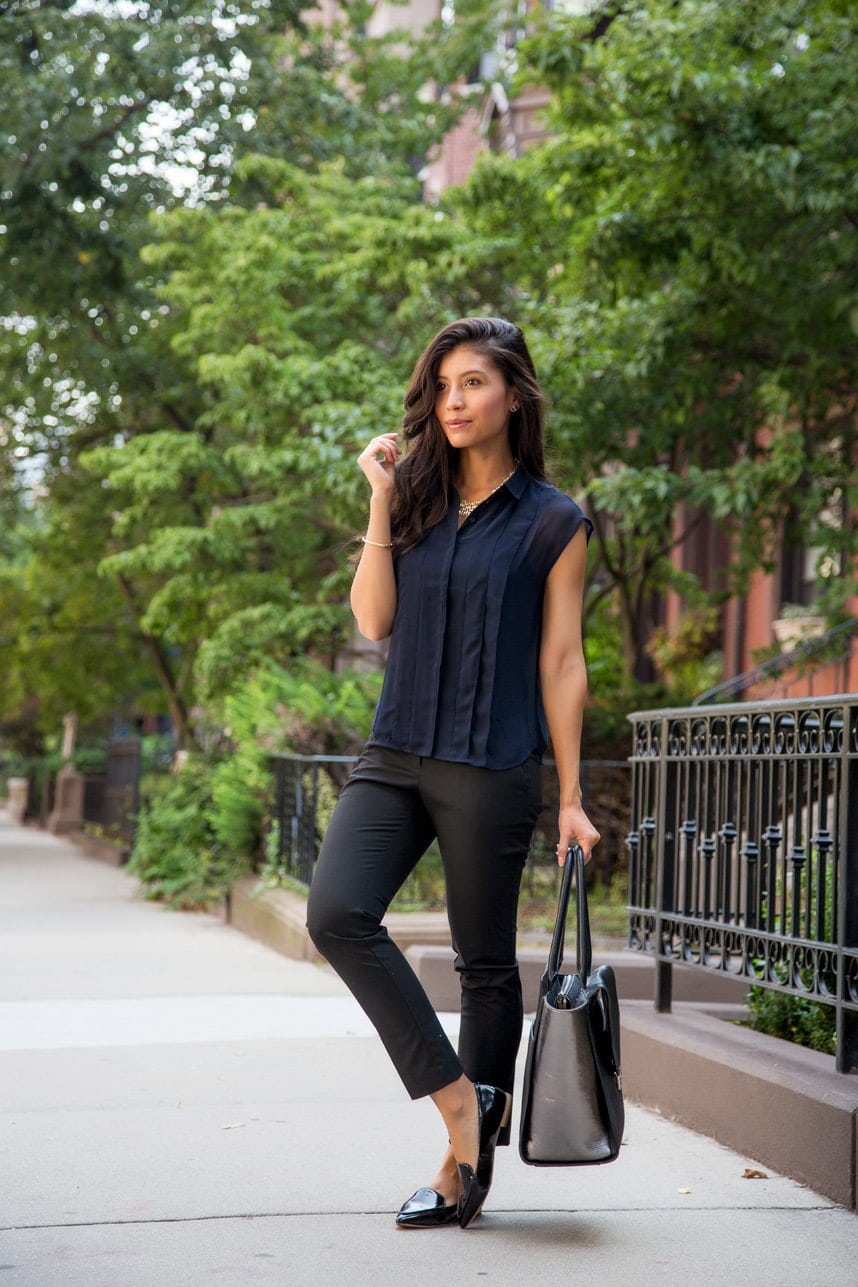
Shop Business Casual Attire
BUSINESS CASUAL FOR WOMEN ATTIRE GUIDE
Trying to decipher what is business casual for women can be a little difficult in today's work environment. A business casual dress code can vary depending on the company you work for, the work you do on a day-to-day basis, and the city you're based in. As you know a business casual dress code is different depending on which cities, states, and parts of the world you're in. Because dressing appropriately can often make or break a career, it's wise to follow a few simple rules when it comes to business casual for women.
I'll provide you with some essential points and tips to keep in mind, for everyday business casual wear, special events, casual work outfits, and business travel. For further style advice on business casual, I've listed at the end of this guide what not to wear when it comes to business casual for women.
If you're looking for a variety of ideas and inspiration make sure to check out 20 Business Casual Outfits for Women, this guide explains the business casual essentials you need and how to put them together to create stylish outfits.
So let's get started!
WHAT IS BUSINESS CASUAL FOR WOMEN?
The easiest way to think of business casual is a hybrid of business professional and casual wear. Business casual is not wearing a full-on suit, but a strapless sundress with flip-flops is not appropriate. It's more about mixing elements of more formal business attire, like a blazer, suit skirt, or pants in neutral colors with more casual pieces like a patterned shell top or leopard print flats.
For the majority of companies, business casual is a daily requirement. So understanding how to put together stylish work outfits is essential if you don't work from home.
It's wise to have the majority of your main business clothing in neutral colors: black, gray, navy, brown, beige, and white. Starting with essential pieces in neutral colors and then adding pops of color not only allow you to bring some life and personality to your office outfits but you will also get a lot of use from your essential pieces. You could wear a pair of gray trousers two to three times a week and swap the top and accessories. If you get a pair of bright printed pants, you would only get away with wearing them once in a while as they would be very memorable.
What to Look for In Business Casual Attire
One of the most challenging aspects of dressing for work is finding the right business casual pieces. Shopping for business casual clothing is half of the challenge, then you have to put those items together into stylish and comfortable outfits for work.
In the following sections, I'll share a few shopping tips when you're looking to add business casual pants, tops, sweaters, blazers, jackets, dresses, and shoes to your wardrobe. These pieces will help you put together casual work outfits that you'll feel confident in.
WOMEN'S BUSINESS CASUAL PANTS
Pants are an obvious choice and the first option for most business attire. Make sure that they fit you well, are wrinkle-free, and are without frayed hems or ripped seams. I like wool, cotton (including corduroy), linen and gabardine, and you can also add in polyester, which is easy to care for. There is also a nice selection of colored denim available these days, make sure the color is pure with no fading, and it's good to have a bit of stretch in them to make them more comfortable for sitting for long periods.
Basic neutrals work best, as you can pair them with a lot of colored tops, but you can opt for colored pants in a dark muted color like burgundy or forest green. You can also try pinstripes or a small plaid. Mid- or high-rise both work, and the hems can be cuffed or uncuffed. I like wide-legged trousers, but you can also go with a straight leg, boot cut, or ankle-length.
You can also change up the style of your business casual pants during the seasons. During the fall and winter look for thicker fabrics in dark colors and patterns more synonymous with the season.
In the spring and summer look for lighter pants in fabric and color. You also have a lot more options during this time of year. Depending on your style you could even wear wide-leg cropped pants in white or blush.
SHOPPING FOR BUSINESS CASUAL PANTS
When shopping for business casual pants, I usually look for trousers with a medium waistband and no loops for a belt. A wider waistband is supportive and keeps your tummy tucked. Also, if your tummy is a problem area, avoid low- or high-rise styles as it can make it appear more pronounced. If you don't have a problem area around your stomach, you can opt for a thinner waistband.
If you have full hips and thighs, look for minimizing darks and structured fabrics, like tropical wool, which downplay curves. Stretch makes them even more forgiving. Straight or wide legs are best. But if you want a slim cut, skip the super-pegged legs and choose a pair with a little width at the hem to offset hips. It's best to avoid pants with pleats and watch out for pants with vertical pockets that lie along the side seams. The vertical pockets can stick out and make your hips look wider than they are.
If you have a larger behind, wearing a belt with your trousers can bring more emphasis to your posterior. The unnecessary emphasis is one reason I look for pants without belt loops.
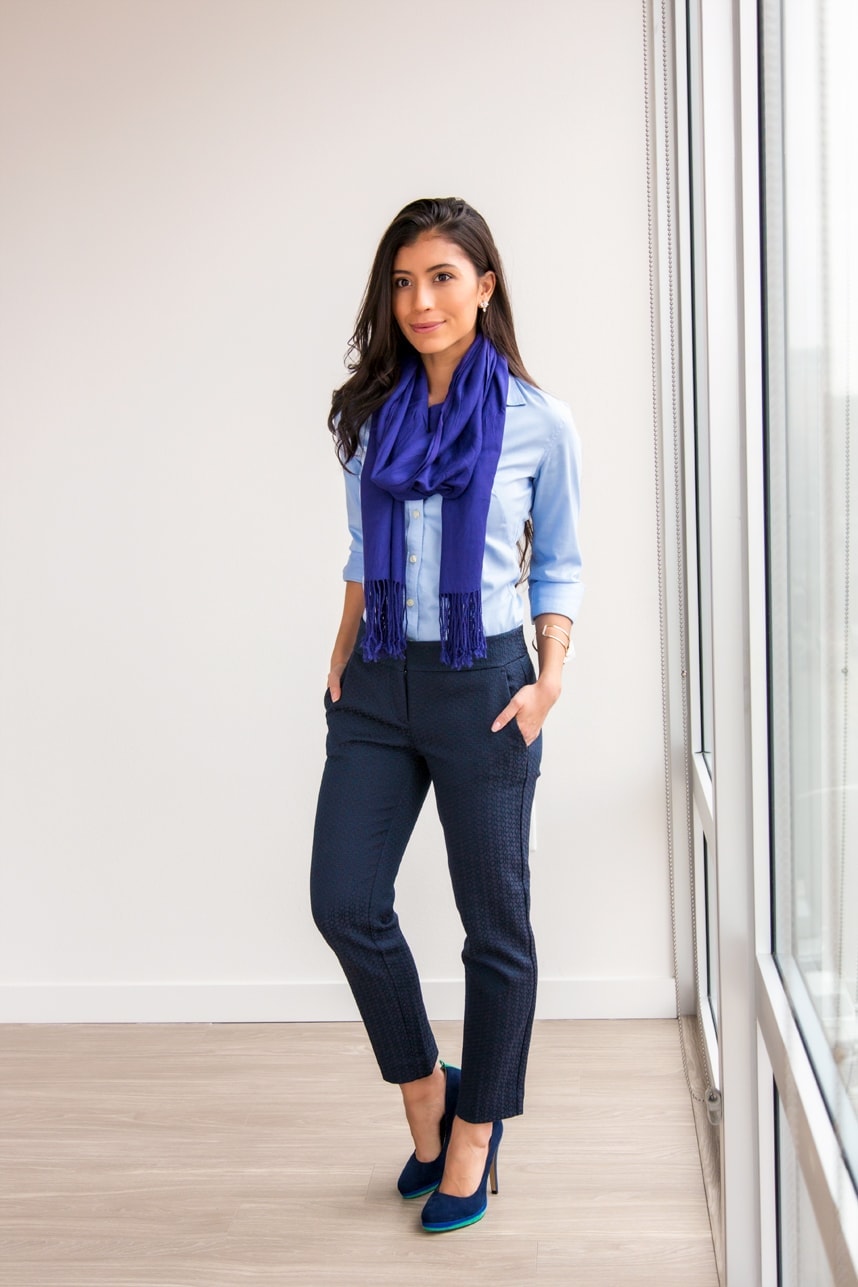
Business Casual Blouses and Tops
To add a pop of color or pattern to an outfit, think blouses and tops. There are a lot of choices out there in pretty colors that will complement your skin tone, eyes, and hair color. Pastels, jewel tones, plaids, muted florals, and prints (paisley, geometric, polka dot, ikat) are all acceptable.
In colder months, stick with long or ¾ sleeves; for spring and summer, short or cap sleeves work well, and you can even wear a wide-strapped tank. In the warmer months look for light blouses with cap sleeves, sleeveless, and shell tops in silk, light cotton, or other light fabrics for your business attire.
Keep your neckline somewhat modest with a collared, boat neck, square neck, or turtleneck. If you go with a scoop or V-neck, make sure that cleavage is not on display. Keep your shirt tucked in or, if worn out, make sure it covers your waistband by several inches. And it should go without saying that you must wear a bra, and a tank or camisole if your blouse is at all sheer.
SHOPPING FOR BUSINESS Blouses and Tops
Shirts and tops are a category where you have almost unlimited options. It's easy to get carried away because of the variety and affordable options. You'll invest more money in pants and blazers as those are the work essentials that you'll wear over and over through the years. But with tops, you don't need to invest so much in them as you'll most likely want to add a few new business casual blouses every year.
In summer and spring look for shirts in bright colors and fun prints. Like polka dots, florals, lace, windowpane, stripes, leaf prints, and mixed prints. If you light colors on the lighter side, opt for blush, pale yellow, pink, baby blue, light gray, or cream. If you love brights, look for tops in pink, green, yellow, orange, red, and bright blue.
I know it can get cold in the office so even if you wear a sleeveless silk top you might want to layer with a blazer. In the business casual outfit below I paired a green silk polka dot top with a striped blazer. The two colors look great together and added neck detail on the shirt adds to the dimension and looks great against the straight-cut blazer. This is the variety and fun you can have with business casual
Shop for Business Casual Tops
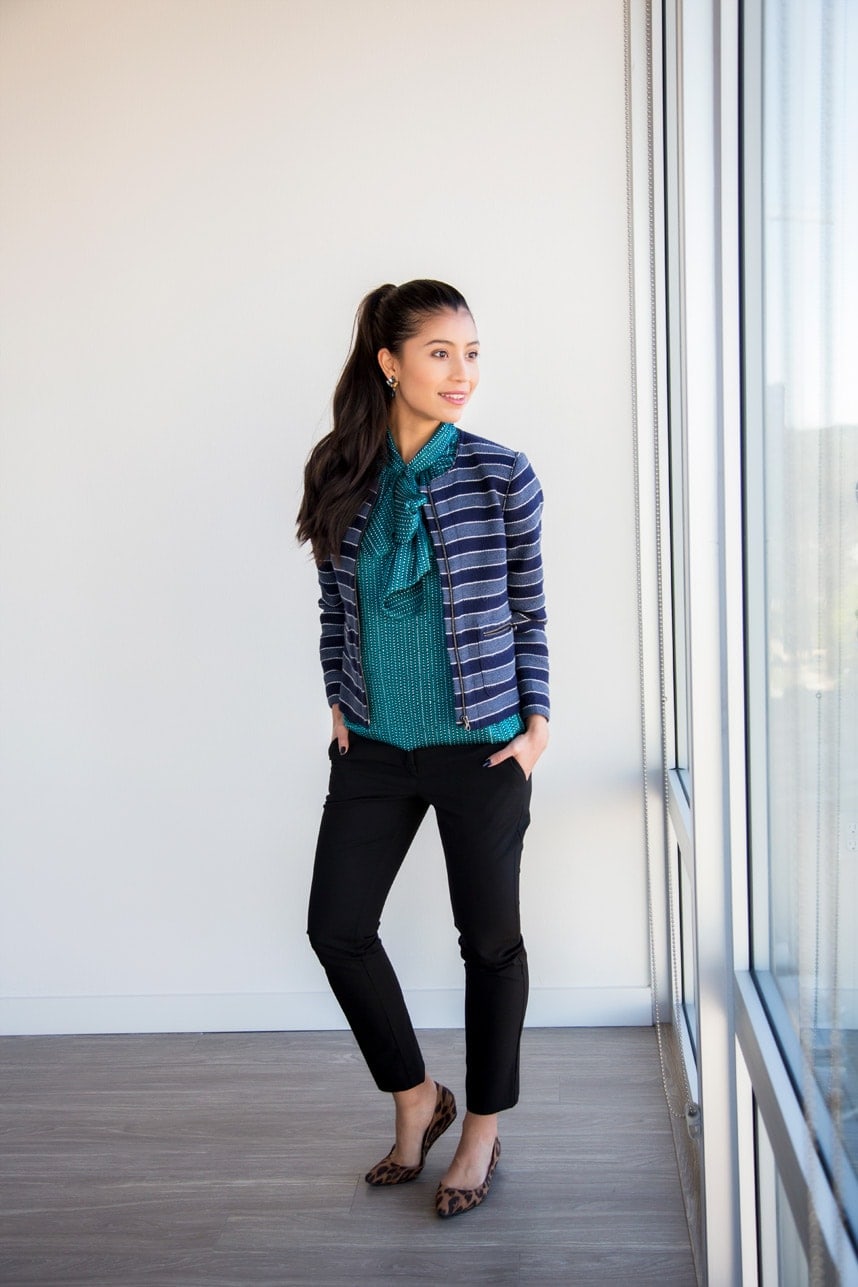
Business Casual Sweaters
You can also wear sweaters in a variety of ways, either as a top or over a shirt if you want to layer, with pants or a skirt, or over a dress. The fit of the sweater is essential here, so try to stay away from anything too baggy or ill-fitted. Fine-gauge knits work best; bulky sweaters not so much.
Your basic business casual cardigan is a staple in business casual attire, and it can be a simple waist-length cardigan or a longer boyfriend one. Your sweater can have buttons, no buttons, or a draped front collar. With longer cardigans, you can even use a skinny belt to add some definition and a different look to an outfit.
My favorite types of sweaters to wear to the office is thin, v-neck, long sleeve sweaters, like the pink one I'm wearing below. I love business casual sweaters because you can layer a button-down shirt underneath and pop out the collar over the sweater like in the outfit example below. The bright pink sweater is a high contrast between the striped collard shirt and black bottoms.
Another business casual sweater that I believe is essential is the simple long black cardigan. You can see in the outfit below I paired it with the pink v-neck sweater, this is an excellent option for fall and the colder months. You can layer a business casual cardigan over a variety of outfits, and it's also very comfortable.
Shop Business Casual Sweaters
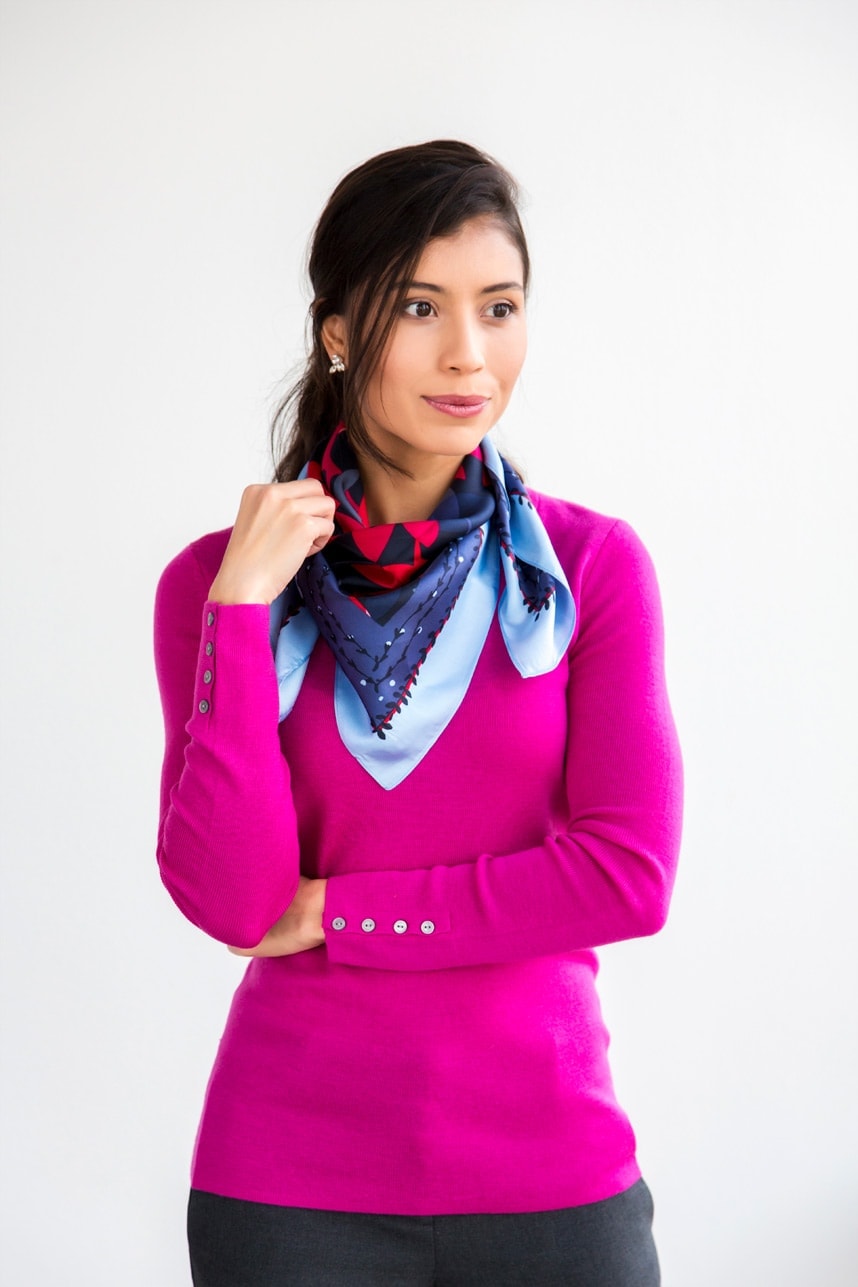
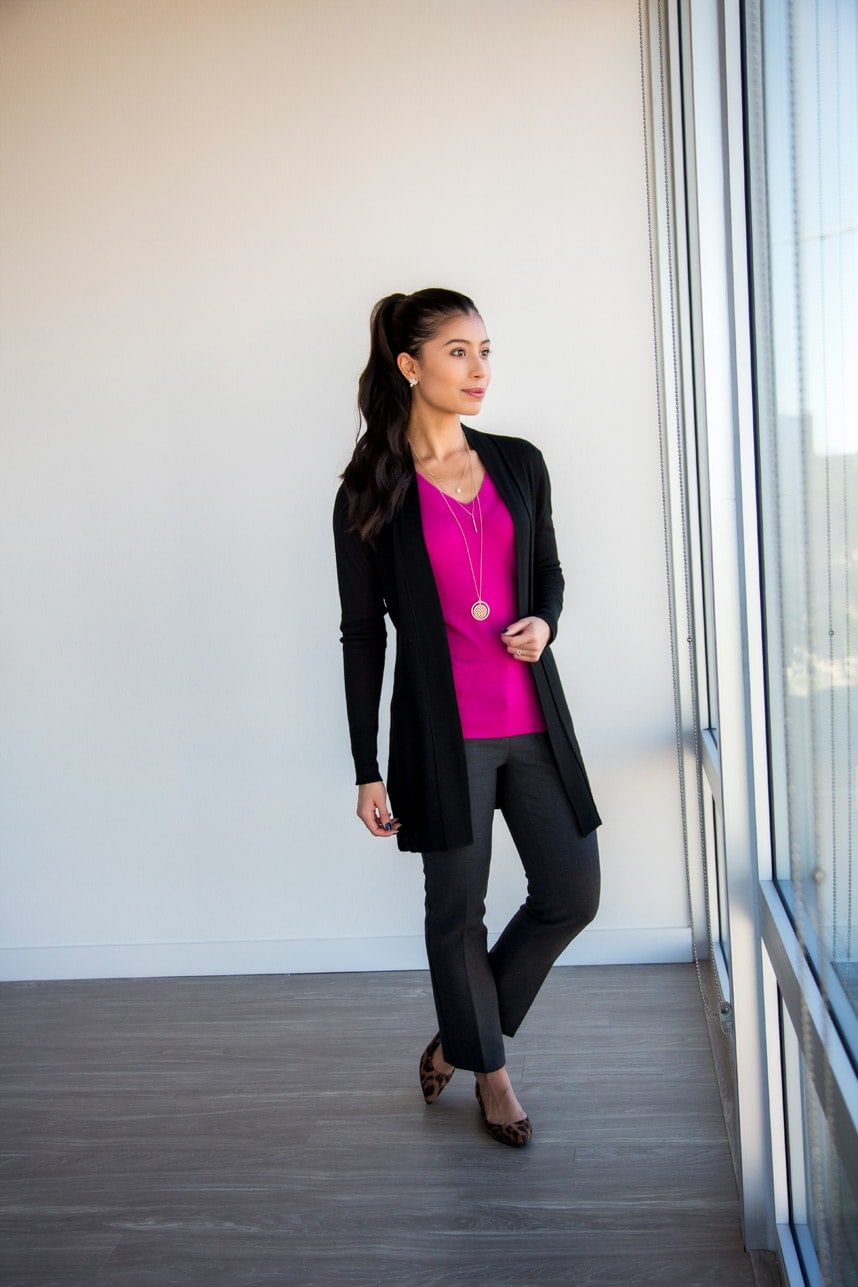
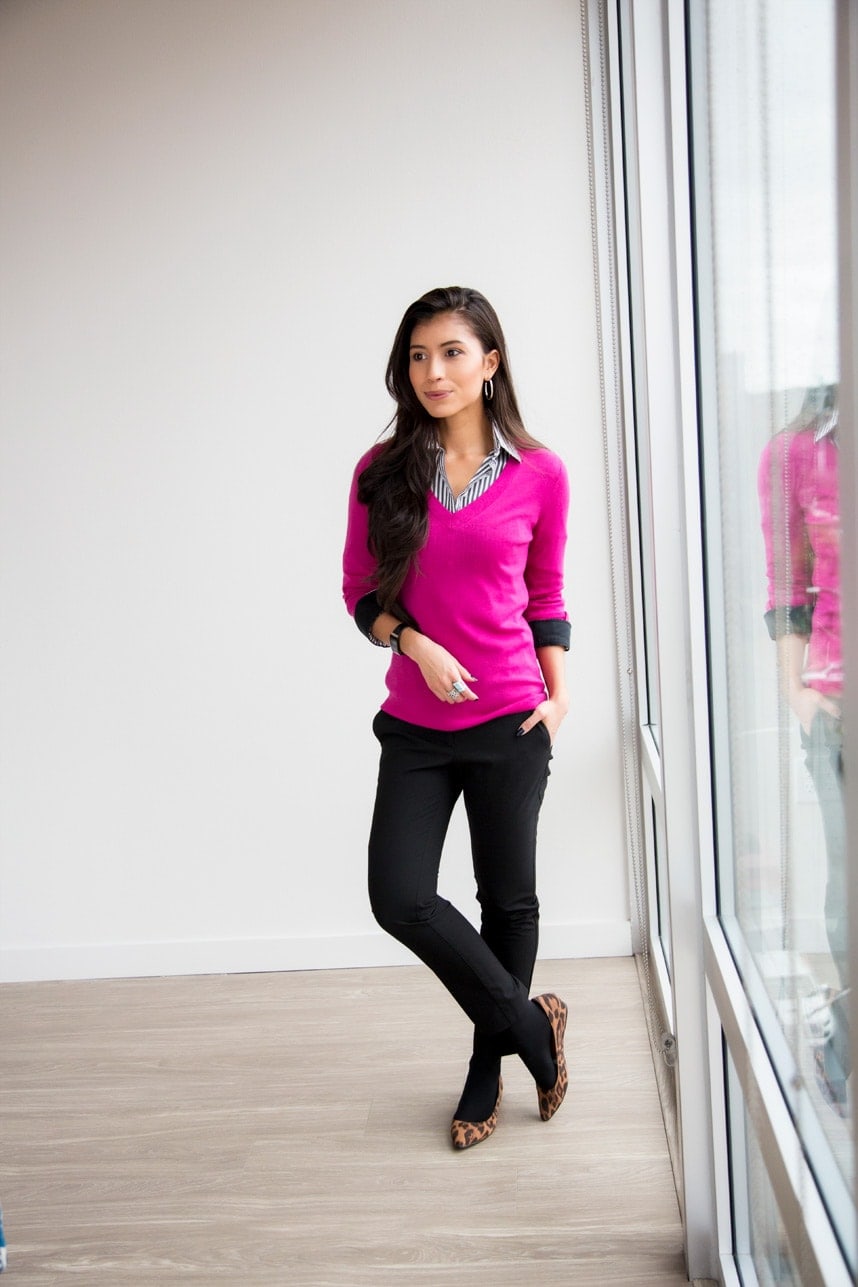
Business Casual Jackets or Blazers
Jackets or blazers are more of a requirement during colder months for warmth going to and from home, not necessarily to wear in the office since this is business casual attire. But don't think that means you can throw on that denim jacket and get away with it. You still need your outerwear to be professional-looking. (You never know when you might need to go to lunch with the boss or a client!)
To get the most bang for your buck, stick with neutral colors; black, charcoal, brown, and navy work best. If you want something a bit different, try a jewel tone, small pinstripe, or herringbone pattern, very classic. The fit is a big issue with jackets and blazers. Nix the boxy blazer and stick to something that nips in at the waist. Make sure that the jacket doesn't pull or gape when buttoned. As an alternative to a blazer, you can try a wool moto jacket.
I love to layer blazers over all my business casual outfits because you never know how cold an office or location will be. So instead of being cold, you are prepared and also look stylish. In the outfit below I cuffed my blazer sleeve to soften the look and show off the cute striped lining. In the business casual outfit below I layered the blazer over a forest green dress. Added a skinny belt to the dress to create some definition and added a pretty silk neck scarf to brighten up your business attire and also soften the outfit.
Shop Business Casual Blazers
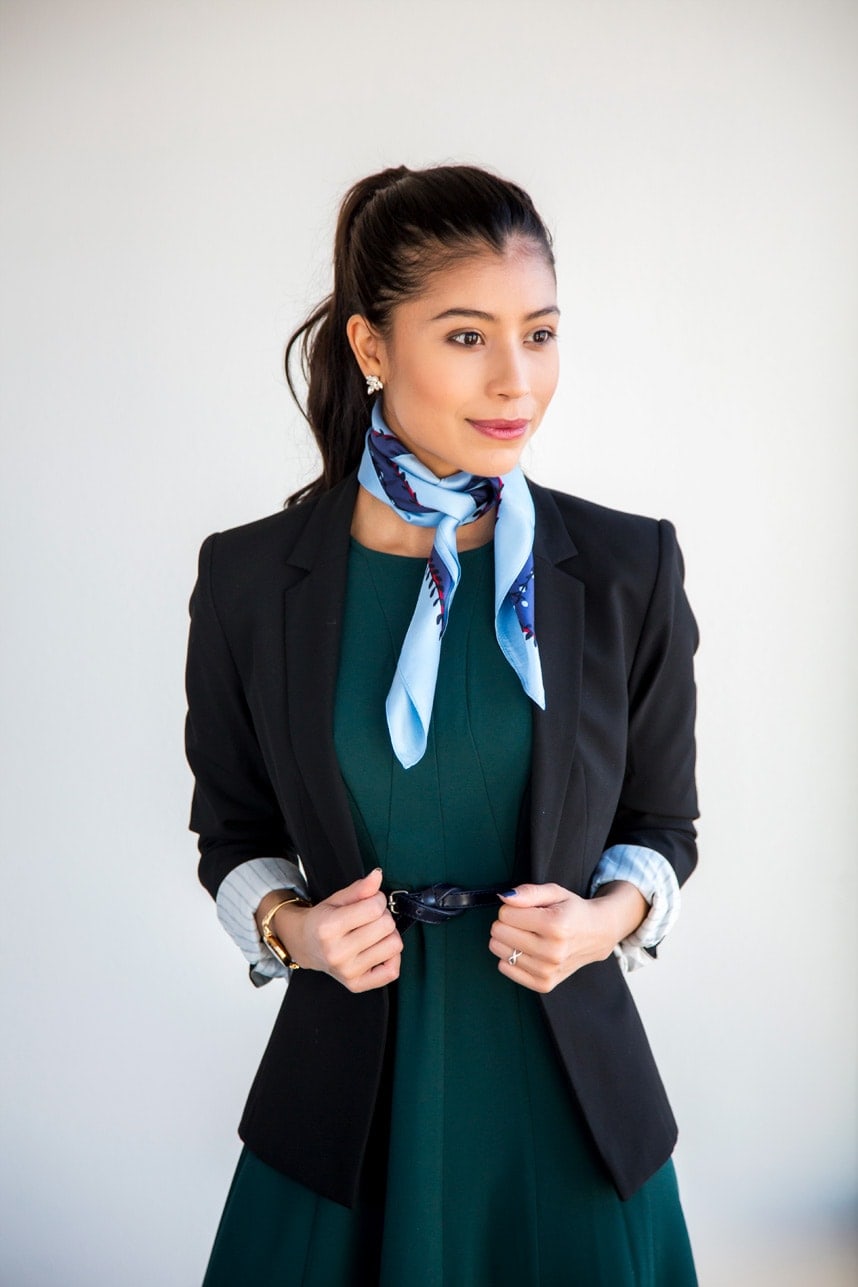
Business Casual Skirts or Dresses
While pants might be your go-to business casual attire, don't forget about skirts and dresses for casual work outfits. The blouses that you wear with your pants will most likely pair well with a skirt. Try a pencil, A-line, or pleated skirt in a solid color or a pinstripe or herringbone pattern. If the skirt has a slit, make sure it is a modest one and appropriate when sitting. Try a variety of colors and prints to see which style you like best. Ann Taylor always has so many nice options to choose from.
Dresses are a natural choice for business casual attire. It's one item on and off you go to work. With dresses, you don't have to worry about what pants match which top or vice versa. They also work well with business casual cardigans and blazers when the weather is chillier. Necklines and sleeves should follow the rules noted above for blouses. Hemlines for both skirts and dresses can range from a few inches above the knee to just below the knee. Minis, high-low, and asymmetrical hemlines are best left in the closet during the week.
To accessorize a simple dress think about adding a silk scarf in a pretty print and color. If you need styling ideas on wearing a scarf with various outfits check out, Ways to Wear a Scarf & How to Tie a Scarf: The Definitive Guide.
Shop Business Casual Skirts & Dresses
5 Business Casual Dress Shopping Tips
1. Business Dress Length
The length of a dress or skirt should not be so short that you feel uncomfortable. Look for a skirt length that ends right above the knee or, if you are tall, a mid-thigh length. This length will make it easy to get up and down out of chairs and appropriately cover you if you are walking upstairs or on an escalator.
2. Business casual Necklines
Necklines of both dresses and blouses need to be somewhat modest and not show too much—if any—cleavage. Leave the plunging V-necks and halters at home. Try a happy medium, wearing a modest v-neck, round or scoop neck, boat neck, square, keyhole, or collared style. And also consider your body shape. If you have a larger chest avoid, high necklines, boat necks, or keyholes, and opt for a v-neck or scoop neck. If you have a smaller chest, you can get away with wearing a boat neck and necklines such as the dress I'm wearing.
3. Sleeves for business casual
Usually, offices are on the cold side, so for dresses opt for longer sleeves. You can go full-length with a cuff or try a three-quarter-length sleeve, which is said to be the most flattering. A three-quarter sleeve ends between your wrist and your elbow.
The lower the sleeve is on your forearm; the thinner your arm will appear. So a three-quarter sleeve length has many positives. It's office-appropriate, it's the most flattering, it hides your arms if you're self-conscious about them, and you won't be as cold. Layer with a cardigan or jacket like I did in this outfit if your office is on the colder side and you can easily remove the layer as needed.
4. Clothing Fit
The fit of your dress is probably paramount. Fit = Appropriateness. Too tight is certainly frowned upon and looks unprofessional, while at the other end of the spectrum, baggy and ill-fitting clothes won't do your figure any justice and tend to look sloppy. Look for dresses that are loose but accentuate the waist. You want the dress to be figure-flattering, but not just figure-focused. A-line, shift, sheath, and classic wrap dresses are all good choices.
5. Color or Print
Your style will help dictate the color or print of your garment. When it comes to solid-colored dresses, you'll want to wear colors that look best with your skin tone. Of course, you can also go with basic black or navy which will make everyone look nice, but dare to try a color like burgundy, midnight blue, red, or forest green. In addition to wearing colors that look good with your skin tone look for colors that go with the seasons.
And don't be afraid of prints. Florals, pinstripe, windowpane, plaid, or houndstooth prints are all great.
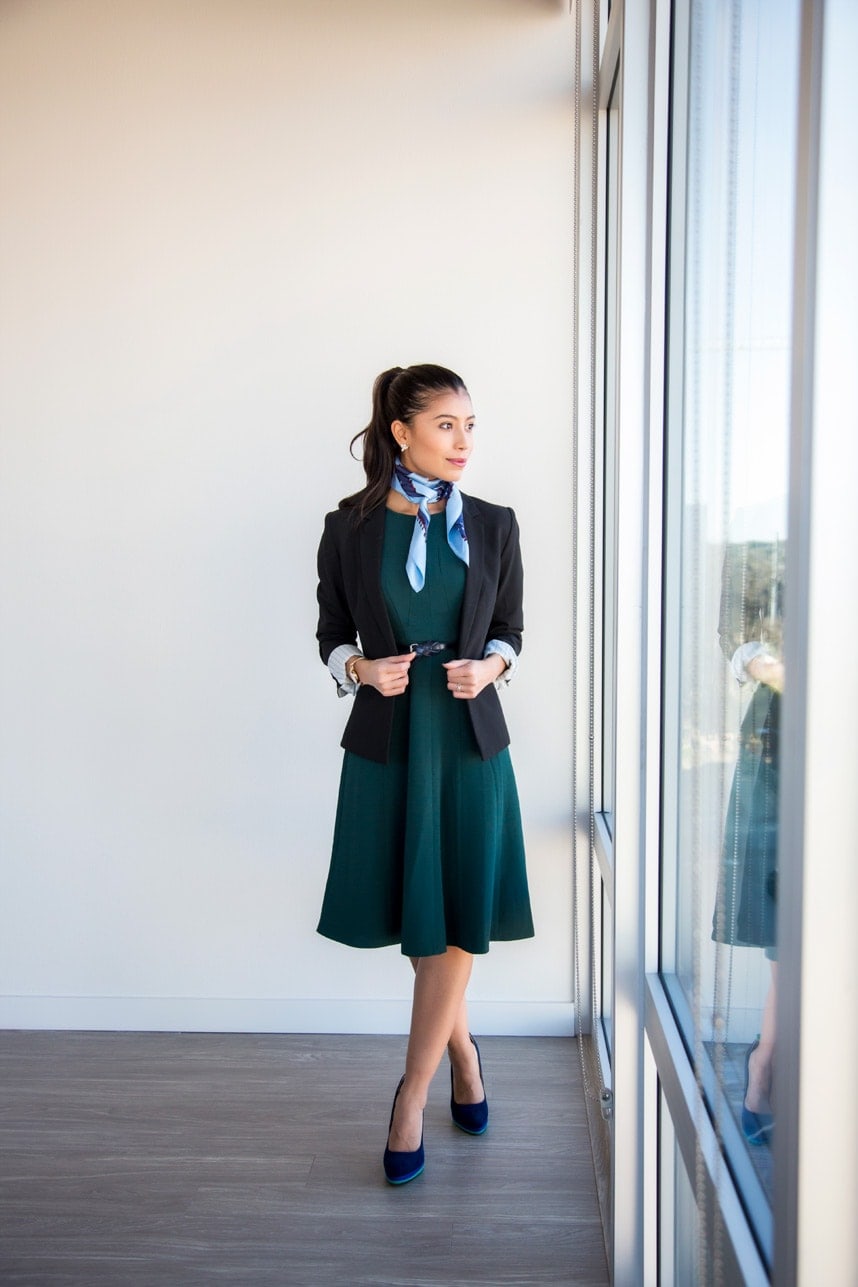
Business Casual Shoes
When it comes to shoes, you've got a lot of great options. Flats, wedges, heels, boots, and certain sandals can be worn with your business casual outfits. Flats are a comfortable option, worn primarily with pants. Try a loafer or driving moc, round or pointed toe ballerina style, or even an oxford.
Heels are more typical in a work environment, but keep them around 4 inches or less, to be both appropriate and more comfortable. You can slip your feet into pumps, slingbacks, T-straps, peep-toe, or wedged heels. And if you are going to be walking around a lot or on your feet for most of the day either opt for flats or a very thick block heel. Skinny heels will get you tired quicker.
Color is excellent for both flats and heels, as is a subtle animal print. During the colder months, pull on a pair of booties or knee-high boots, either flat, heeled, or with a wedge. Boots should be leather (or vegan alternative) and in a neutral color without over-embellishment (multiple buckles, say). While nylons and stockings are not required with your shoes, they certainly can be worn, as can tights and socks with boots.
You can also opt for heeled sandals, rather than close-toed shoes. As with general casual shoes, the height should be around 4 inches or lower and can include a wedge. Try to avoid dressier sandals that have embellishments, lots of straps, or look like they belong at a club. And, sadly, flat sandals are really not appropriate for most business casual work environments.
Shop Business Casual SHoes
When I go shopping for professional gear there are a few things I keep in mind.
Purchase Business Casual Neutrals
If I'm shopping for super essentials like; trousers, blazers, pencils skirts, etc, I almost always buy neutral colors – especially if the business casual attire is on the pricier end of the spectrum like $100+ I purchase them in colors like gray, navy, black, and white. The main reason to buy clothing in neutrals is to get the most use out of the item of course! If I'm spending more than $100 on an item, I want it to last, and I want to wear it over and over again. And for these types of business casual attire I know I'm going to keep them for a long time, so it's worth the investment.
For less expensive items, like cute tops or a fun pair of pants that are on sale, ahead and get printed, bright, and fun colors to bring some vibrancy to my office attire. It's important to note where your money is going. Don't spend a ton of money on a printed top you'll only wear a couple of times a year. Save that money for the perfect pair of trousers.
Get Essentials on Sale
Always buy items on sale! Departments stores and specialty stores like Ann Taylor, LOFT, and JCrew, always have sales going on! Like all the time. There is no need to buy something at full price to create stylish work outfits. If you find an item you like, save it on Pinterest or on your account to come back to it over the weekend. Sales usually happen on the weekends or holidays. When shopping online use tools like Honey or RetailMeNot to find coupon codes! If you're at the store ask an associate when the next sale will be and if they offer a price adjustment period. Many retailers now give you a price adjustment if the price is lowered within a certain amount of days of the original purchase. Make sure to check out their website's FAQ section for specifics.
Have Your Shopping List Ready
Know what you're looking for before you go shopping! Always shop with intention, unless you're shopping for fun and just browsing to see what you like. Have a list of items you need. This is the reason for the essential list. It's important to know what you want before you shop online or at a store. When you go in without a purpose you wander around the store, try some things on, and then end up buying something that goes with nothing in your closet.
Consider the big picture. Before you purchase any item consider how it will add to your wardrobe. What do you already own that you can wear with? Does it match your wardrobe? Don't buy a single piece you're not sure what to pair with.
Consider Summer Outfits for Work
Summer presents some challenges for women when choosing business casual outfits. The heat or humidity in many locations warrants wearing as little as possible, which isn't appropriate for the office. Instead, wear clothing made from breathable material (cotton, silk, linen) and lighter in color.
If pants are your average daily attire, go for lightweight cotton or linen in white, cream, or beige. Pair your pants with a wide-strapped tank in a pretty color or wear a slightly sheer blouse with a camisole that will help to wick away the moisture.
Better yet, switch to skirts and dresses. Both of these items allow air to circulate below the knee and, yes, up the skirt. Wear skirts and dresses that have some movement, rather than a pencil skirt that hugs the body. Pair skirts with tops that have short or cap sleeves or that wide-strap tank or semi-sheer blouse with a camisole, so you stay fresh throughout the day.
WHAT TO WEAR TO A BUSINESS CONFERENCE
When you find out you're headed to a business conference, there are a few things that come to mind!
"Yay, I get to travel! I hope I have time to sightsee."
"Hmmm, what should I wear to the conference?"
The location of the conference, the weather, and the industry that you're in will determine the type of outfits you should wear to a business conference.
Let's use the conference I went to as an example. I live in California, and the conference was in Boston. The conference was week-long and lasted all day. Industry business owners and professionals from all over the world were attending this conference, so I knew I was going to be meeting a lot of people. The conference was in September, so I knew it wasn't going to be too hot or too cold.
From these points, I realized that business casual and layering was the best way to go. It allowed me to be comfortable for a packed day of events.
You might need to add in a more traditional business suit or a fancier dress for an evening event. So be sure to check the schedule and plan for the unexpected. I'd rather pack a fancy dress than have to run out at the last minute to find one, or risk being embarrassed by wearing a business casual outfit to a fancy client dinner.
So here's what I packed for that conference.
WHAT I PACKED FOR A 5-DAY BUSINESS CONFERENCE
Having to pack for a conference entails not only clothing but a computer, business cards, handouts, etc., all of which take up room in a suitcase or carry-on. So when it came time to pack for this conference, I knew I didn't want to pack a lot of clothes. I tried to take items that I would be able to mix and match to create a variety of outfits.
So to create five different business casual outfits for this conference these are the items I took with me:
- Black Trousers
- Tan Trousers
- Black Cardigan
- Black Flats
- Navy Heels
- Large Tote
- Dress
- Polka Dot Top
- Navy Blouse
- Burgundy Blouse
These ten pieces made up the week of outfits I needed. It might not seem like a lot of clothes, but the key is finding pieces that you can mix and match.
I opted for darker hues as it was almost the fall season, and they are easier to mix and match. A lot of the items I packed were neutrals, so to add some personality I added a fun polka dot top and a patterned dress. You could also add in scarves or jewelry which can change up a look.
The outfit I'm wearing in this post is the complete outfit I wore at the conference. Check out How to Dress Professionally, Feel Confident and Look Stylish to view the first business casual outfit.
WHAT IS NOT Business Casual for Women?
While the business casual dress code for women isn't written in stone, there are some hard and fast rules on what not to wear.
Here is what you should avoid when the dress code for women is business casual. Remember you want to keep it classy.
- jeans or denim
- low-rise pants
- capri pants
- shorts or skorts
- sweatpants or yoga pants
- overalls
- leather pants or skirts
- short/mini skirts or dresses
- body-con dresses
- ankle- or full-length dresses
- tops or dresses with a plunging neckline
- tops or dresses with skinny straps
- crop tops/halters/razorback/strapless
- flat summer sandals or flip flops
- baggy clothes
- super tight clothes
- sundresses
- sequins
- neon
- bra showing
- clogs/stilettos/high-platform shoes
- Nothing that looks like you're hanging out with friends, going to a picnic, going to a party/club, or going on a date.
This "what not to wear" is not a comprehensive list, but it does give some key points on what you should not wear.
10 Style Tips for Business Casual Outfits
- 1. Sleeveless tops should extend to the edges of your shoulders. No spaghetti straps.
- 2. Your neckline should never be lower than 4 inches below your collarbone.
- 3. Make sure all items are pressed and as wrinkle-free as possible.
- 4. Don't go overboard with print mixing. A subtle stripe and floral/leopard are on point.
- 5. If you wear a slightly sheer top, make sure to top it with a blazer. Wear a camisole underneath to be extra safe.
- 6. The safest hemline is at the knee. Never go shorter than a few inches above the knee.
- 7. If you want to wear a bold piece like printed pants, balance it with minimalistic items, like a crisp white blouse.
- 8. Add pops of color or even pops of print!
- 9. Nail down some confidence-boosting pieces, like a suit, well-fitted blazer, pencil or A-line skirt, and a silk blouse.
- 10 If you're going to wear jeans do dark wash or black.
I hope this post has helped you in figuring out what is business casual and how women can dress appropriately and Stylish at the office!
If you have any other questions about business casual attire, just leave me a comment!
Stay Stylish,
-V
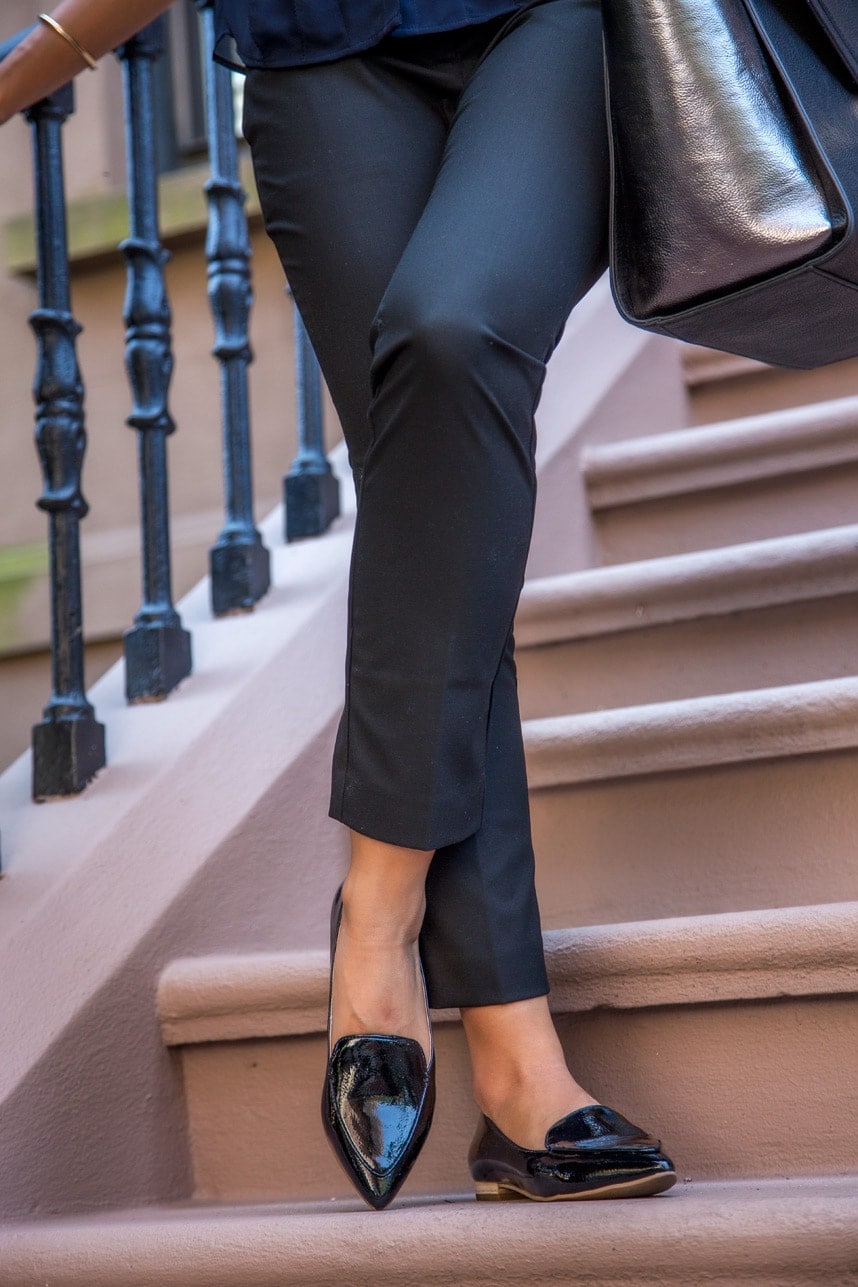
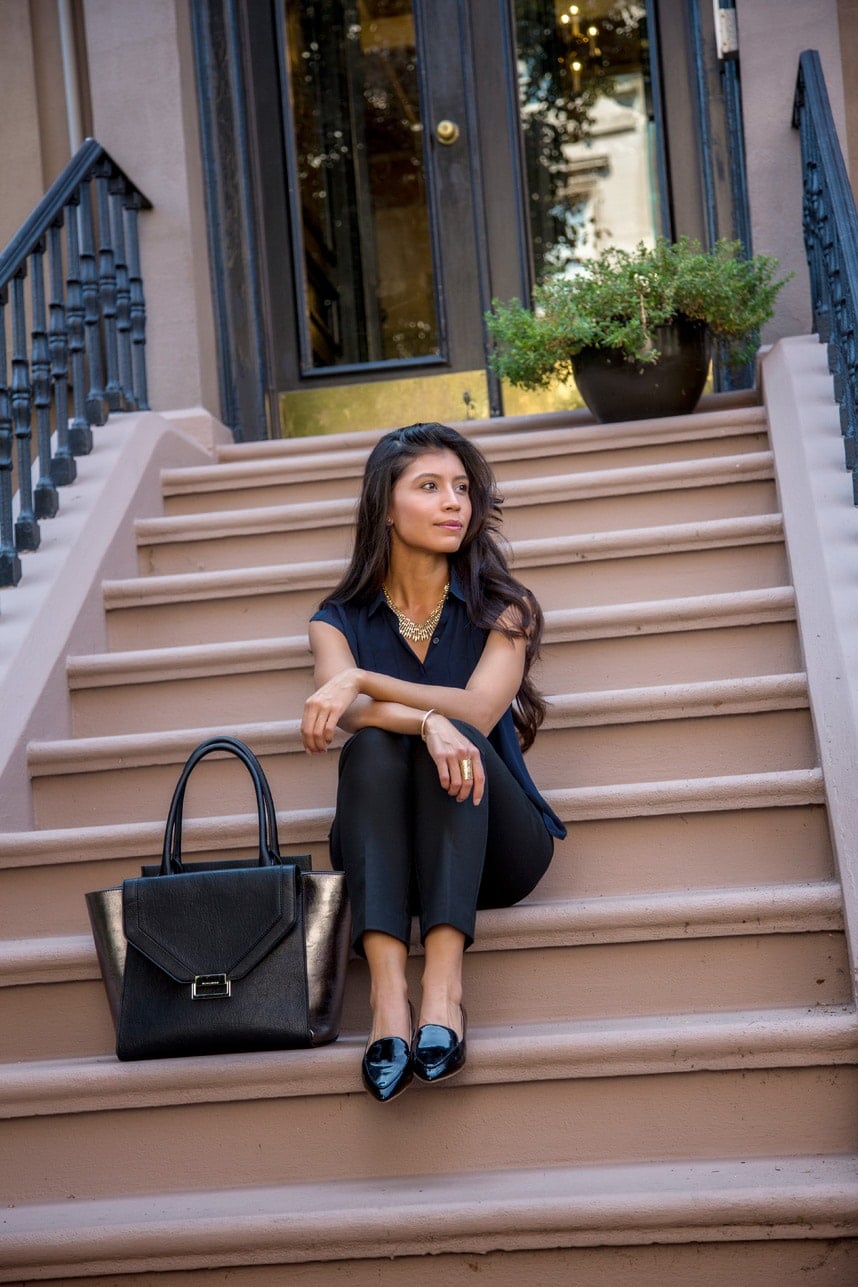
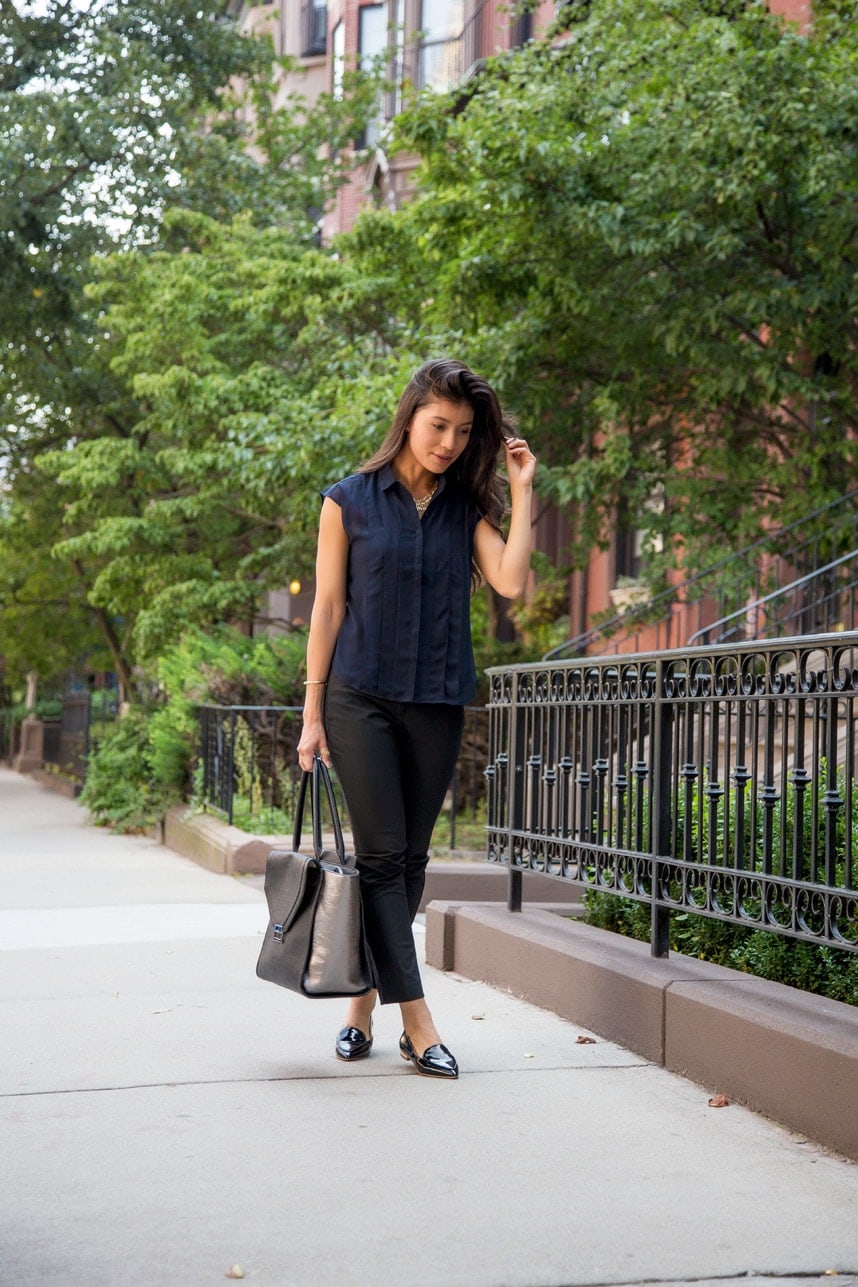
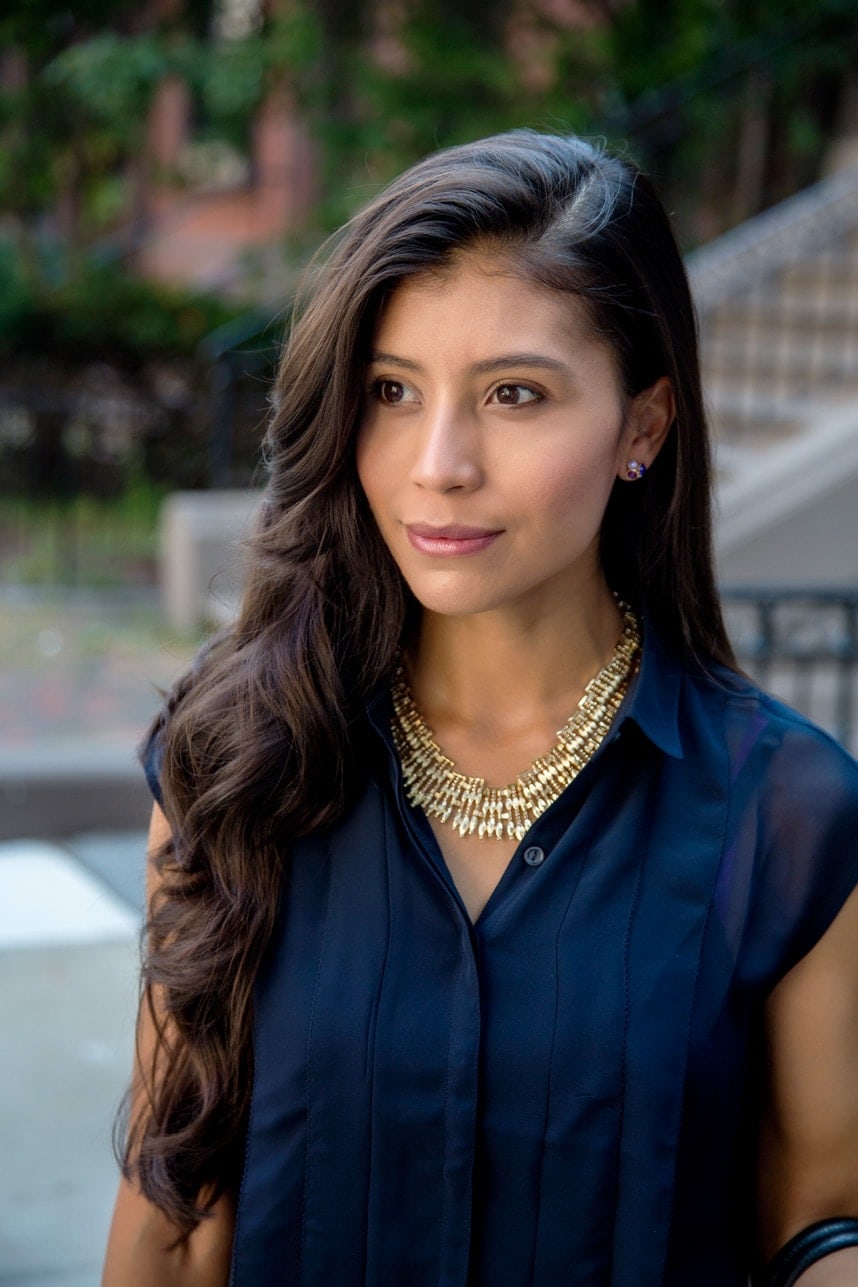

Source: https://stylishlyme.com/what-to-wear/business-casual-attire-for-women/

